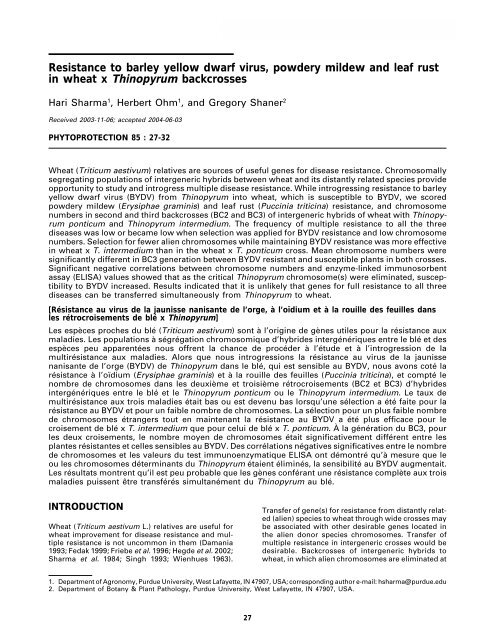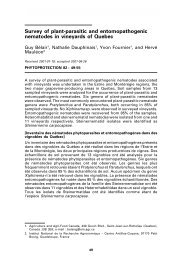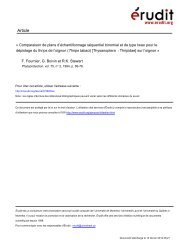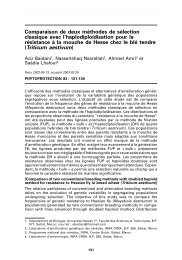Resistance to barley yellow dwarf virus, powdery mildew and leaf ...
Resistance to barley yellow dwarf virus, powdery mildew and leaf ...
Resistance to barley yellow dwarf virus, powdery mildew and leaf ...
Create successful ePaper yourself
Turn your PDF publications into a flip-book with our unique Google optimized e-Paper software.
SHARMA ET AL. : MULTIPLE DISEASE RESISTANCE IN WIDE CROSSES<br />
<strong>Resistance</strong> <strong>to</strong> <strong>barley</strong> <strong>yellow</strong> <strong>dwarf</strong> <strong>virus</strong>, <strong>powdery</strong> <strong>mildew</strong> <strong>and</strong> <strong>leaf</strong> rust<br />
in wheat x Thinopyrum backcrosses<br />
Hari Sharma 1 , Herbert Ohm 1 , <strong>and</strong> Gregory Shaner 2<br />
Received 2003-11-06; accepted 2004-06-03<br />
PHYTOPROTECTION 85 : 27-32<br />
Wheat (Triticum aestivum) relatives are sources of useful genes for disease resistance. Chromosomally<br />
segregating populations of intergeneric hybrids between wheat <strong>and</strong> its distantly related species provide<br />
opportunity <strong>to</strong> study <strong>and</strong> introgress multiple disease resistance. While introgressing resistance <strong>to</strong> <strong>barley</strong><br />
<strong>yellow</strong> <strong>dwarf</strong> <strong>virus</strong> (BYDV) from Thinopyrum in<strong>to</strong> wheat, which is susceptible <strong>to</strong> BYDV, we scored<br />
<strong>powdery</strong> <strong>mildew</strong> (Erysiphae graminis) <strong>and</strong> <strong>leaf</strong> rust (Puccinia triticina) resistance, <strong>and</strong> chromosome<br />
numbers in second <strong>and</strong> third backcrosses (BC2 <strong>and</strong> BC3) of intergeneric hybrids of wheat with Thinopyrum<br />
ponticum <strong>and</strong> Thinopyrum intermedium. The frequency of multiple resistance <strong>to</strong> all the three<br />
diseases was low or became low when selection was applied for BYDV resistance <strong>and</strong> low chromosome<br />
numbers. Selection for fewer alien chromosomes while maintaining BYDV resistance was more effective<br />
in wheat x T. intermedium than in the wheat x T. ponticum cross. Mean chromosome numbers were<br />
significantly different in BC3 generation between BYDV resistant <strong>and</strong> susceptible plants in both crosses.<br />
Significant negative correlations between chromosome numbers <strong>and</strong> enzyme-linked immunosorbent<br />
assay (ELISA) values showed that as the critical Thinopyrum chromosome(s) were eliminated, susceptibility<br />
<strong>to</strong> BYDV increased. Results indicated that it is unlikely that genes for full resistance <strong>to</strong> all three<br />
diseases can be transferred simultaneously from Thinopyrum <strong>to</strong> wheat.<br />
[Résistance au <strong>virus</strong> de la jaunisse nanisante de l’orge, à l’oïdium et à la rouille des feuilles dans<br />
les rétrocroisements de blé x Thinopyrum]<br />
Les espèces proches du blé (Triticum aestivum) sont à l’origine de gènes utiles pour la résistance aux<br />
maladies. Les populations à ségrégation chromosomique d’hybrides intergénériques entre le blé et des<br />
espèces peu apparentées nous offrent la chance de procéder à l’étude et à l’introgression de la<br />
multirésistance aux maladies. Alors que nous introgressions la résistance au <strong>virus</strong> de la jaunisse<br />
nanisante de l’orge (BYDV) de Thinopyrum dans le blé, qui est sensible au BYDV, nous avons coté la<br />
résistance à l’oïdium (Erysiphae graminis) et à la rouille des feuilles (Puccinia triticina), et compté le<br />
nombre de chromosomes dans les deuxième et troisième rétrocroisements (BC2 et BC3) d’hybrides<br />
intergénériques entre le blé et le Thinopyrum ponticum ou le Thinopyrum intermedium. Le taux de<br />
multirésistance aux trois maladies était bas ou est devenu bas lorsqu’une sélection a été faite pour la<br />
résistance au BYDV et pour un faible nombre de chromosomes. La sélection pour un plus faible nombre<br />
de chromosomes étrangers <strong>to</strong>ut en maintenant la résistance au BYDV a été plus efficace pour le<br />
croisement de blé x T. intermedium que pour celui de blé x T. ponticum. À la génération du BC3, pour<br />
les deux croisements, le nombre moyen de chromosomes était significativement différent entre les<br />
plantes résistantes et celles sensibles au BYDV. Des corrélations négatives significatives entre le nombre<br />
de chromosomes et les valeurs du test immunoenzymatique ELISA ont démontré qu’à mesure que le<br />
ou les chromosomes déterminants du Thinopyrum étaient éliminés, la sensibilité au BYDV augmentait.<br />
Les résultats montrent qu’il est peu probable que les gènes conférant une résistance complète aux trois<br />
maladies puissent être transférés simultanément du Thinopyrum au blé.<br />
INTRODUCTION<br />
Wheat (Triticum aestivum L.) relatives are useful for<br />
wheat improvement for disease resistance <strong>and</strong> multiple<br />
resistance is not uncommon in them (Damania<br />
1993; Fedak 1999; Friebe et al. 1996; Hegde et al. 2002;<br />
Sharma et al. 1984; Singh 1993; Wienhues 1963).<br />
Transfer of gene(s) for resistance from distantly related<br />
(alien) species <strong>to</strong> wheat through wide crosses may<br />
be associated with other desirable genes located in<br />
the alien donor species chromosomes. Transfer of<br />
multiple resistance in intergeneric crosses would be<br />
desirable. Backcrosses of intergeneric hybrids <strong>to</strong><br />
wheat, in which alien chromosomes are eliminated at<br />
1. Department of Agronomy, Purdue University, West Lafayette, IN 47907, USA; corresponding author e-mail: hsharma@purdue.edu<br />
2. Department of Botany & Plant Pathology, Purdue University, West Lafayette, IN 47907, USA.<br />
27
PHYTOPROTECTION 85 (1) 2004<br />
r<strong>and</strong>om <strong>and</strong> have wide variation for disease reaction<br />
<strong>and</strong> alien chromosome segregation, provide opportunity<br />
<strong>to</strong> investigate whether resistances <strong>to</strong> multiple<br />
diseases, present in the donor parent, are associated.<br />
Barley <strong>yellow</strong> <strong>dwarf</strong> <strong>virus</strong> (BYDV), transmitted by<br />
Rhopalosiphum species of aphid [Homoptera: Aphididae],<br />
is one of the most serious viral diseases of<br />
wheat <strong>and</strong> no resistance genes have been found in<br />
Triticum species (Comeau <strong>and</strong> Plourde 1987; Sharma<br />
et al. 1997a). Thinopyrum ponticum (Podp.) Barkworth<br />
& Dewey (syn. Agropyron elongatum (Host) Beauv.)<br />
<strong>and</strong> T. intermedium (Host) Barkworth & Dewey (syn.<br />
A. intermedium (Host) Beauv.) are resistant <strong>to</strong> BYDV<br />
(Brettell et al. 1988; Comeau <strong>and</strong> Plourde 1987; Sharma<br />
et al. 1995), <strong>leaf</strong> rust (Puccinia triticina Erick.)<br />
(Cauderon et al. 1973; Franke et al. 1992; Knott 1978;<br />
Kochumadhavan et al. 1988; Wienhues 1963), <strong>and</strong><br />
<strong>powdery</strong> <strong>mildew</strong> (Erysiphe (=Blumeria) graminis (DC.)<br />
E.O. Speer) (Franke et al. 1992; Sinigovets 1976). These<br />
diseases are important in soft red winter wheat production<br />
in Indiana (Patterson et al. 1990).<br />
We produced backcross populations from the intergeneric<br />
hybrids of wheat (somatic chromosome number<br />
= 2n = 42) with T. ponticum (2n = 70) <strong>and</strong> T. intermedium<br />
(2n = 42) primarily <strong>to</strong> transfer resistance <strong>to</strong><br />
BYDV from Thinopyrum in<strong>to</strong> wheat (Sharma et al.<br />
1989, 1995). During this introgression for resistance<br />
<strong>to</strong> BYDV, we also compiled data on the reaction of<br />
backcross populations <strong>to</strong> <strong>powdery</strong> <strong>mildew</strong> <strong>and</strong> <strong>leaf</strong><br />
rust along with somatic chromosome numbers of<br />
individual plants. This paper reports the results of<br />
analysis of these four traits in the second <strong>and</strong> third<br />
backcross (BC2, BC3) populations.<br />
MATERIALS AND METHODS<br />
The backcross populations were developed from<br />
wheat x T. ponticum F1 hybrids, <strong>and</strong> wheat x T. intermedium<br />
F1 hybrids. We used soft red winter wheats<br />
in these hybrids <strong>and</strong> backcrosses (Sharma et al. 1989,<br />
1995). The reaction of the F1 hybrids <strong>to</strong> the prevalent<br />
<strong>and</strong> virulent strain PAV of BYDV has been described<br />
earlier (Sharma et al. 1989). The backcross seedlings<br />
at two-three <strong>leaf</strong> stage were first inoculated with BYDV-<br />
PAV by feeding viruliferous aphids on them. Aphid<br />
survival was moni<strong>to</strong>red <strong>and</strong> any plant without live<br />
aphids was reinfected (Sharma et al. 1989, 1995). The<br />
plants were inoculated with Puccinia triticina culture<br />
No. 901 collected in Indiana. For <strong>leaf</strong> rust, the seedlings<br />
were inoculated in a moisture chamber by applying<br />
spore suspension with an au<strong>to</strong>mizer <strong>and</strong> keeping<br />
the seedlings in the moisture chamber overnight<br />
(Shaner et al. 1997). Subsequently, natural infection<br />
by Erysiphe graminis was allowed <strong>to</strong> occur in a greenhouse<br />
where no fungicide was applied. The plants<br />
were grown under 20-25 o C, 14 h light <strong>and</strong> natural<br />
humidity. Scoring was done 12-14 d after inoculation.<br />
We analysed 190 BC2 plants <strong>and</strong> 209 BC3 plants from<br />
the wheat x T. ponticum cross, <strong>and</strong> were able <strong>to</strong> score<br />
all four traits (BYDV, <strong>powdery</strong> <strong>mildew</strong>, <strong>leaf</strong> rust <strong>and</strong><br />
chromosome number) on 28 BC2 plants <strong>and</strong> 49 BC3<br />
plants, <strong>and</strong> all the three diseases on 63 BC2 plants <strong>and</strong><br />
146 BC3 plants. There were 92 BC2 plants <strong>and</strong> 60 BC3<br />
plants from the wheat x T. intermedium cross, of<br />
which 29 <strong>and</strong> 26, respectively, had all the four traits<br />
scored, <strong>and</strong> 54 <strong>and</strong> 28, respectively, had all the three<br />
diseases scored. Checks for the ELISA were oat cultivar<br />
Clintl<strong>and</strong> 64, wheat cultivars Abe, Caldwell <strong>and</strong><br />
Cardinal, T. ponticum <strong>and</strong> T. intermedium. Additionally,<br />
P-PAV <strong>and</strong> healthy (uninfected) Clintl<strong>and</strong> 64 were<br />
included <strong>to</strong> rule out variation due <strong>to</strong> the method. In<br />
the <strong>powdery</strong> <strong>mildew</strong> <strong>and</strong> <strong>leaf</strong> rust tests, the checks<br />
were wheat cultivar Morocco, T. ponticum <strong>and</strong> T.<br />
intermedium. The BC2 populations were r<strong>and</strong>om while<br />
the BC3 were the result of selection in BC2 for fewer<br />
alien chromosomes <strong>and</strong> lower enzyme-linked immunosorbent<br />
assay (ELISA) values (measure of level of<br />
BYDV resistance). Wheat was the recurrent parent.<br />
The Thinopyrum chromosomes do not pair meiotically<br />
with wheat chromosomes due <strong>to</strong> lack of homology<br />
<strong>and</strong> are thus r<strong>and</strong>omly eliminated during backcrossing<br />
(Dvorak 1979; Johnson <strong>and</strong> Kimber 1967; Sharma<br />
<strong>and</strong> Gill 1983). The resistance <strong>to</strong> the diseases studied<br />
thus reflects the effect of the Thinopyrum chromosomes.<br />
The procedure for testing BYDV resistance by ELISA<br />
is given in Sharma et al. (1989). No scoring was done<br />
on the basis of visual symp<strong>to</strong>ms. Unlike oat, the<br />
concentration of <strong>virus</strong> in infected plants was not<br />
consistently correlated with symp<strong>to</strong>m severity in<br />
wheat (Baltenberger et al. 1987, Sharma et al. 1989).<br />
The chromosome numbers were determined from<br />
root-tip cells of the germinated seeds by the Feulgen<br />
method (Metz et al. 1988). Plants for <strong>powdery</strong> <strong>mildew</strong><br />
<strong>and</strong> <strong>leaf</strong> rust were scored as 1 for resistant, 2 for<br />
moderately resistant, 3 for moderately susceptible<br />
<strong>and</strong> 4 for susceptible (Hu et al. 1997; Shaner et al.<br />
1997). Actual ELISA values were used for quantitative<br />
data analysis. For qualitative analysis, plants with<br />
ELISA values 0.3 or less were classified as resistant<br />
<strong>and</strong> those with higher than 0.3 were classified as<br />
susceptible (Sharma et al. 1995). Likewise, for qualitative<br />
analysis of <strong>powdery</strong> <strong>mildew</strong> <strong>and</strong> <strong>leaf</strong> rust, scores<br />
1 <strong>and</strong> 2 were classified as resistant, <strong>and</strong> scores 3 <strong>and</strong><br />
4 as susceptible.<br />
Data analyses were performed using SAS statistical<br />
software (SAS Inst. 1999).<br />
RESULTS AND DISCUSSION<br />
Results of our study showed that the possibility of<br />
having multiple resistance <strong>to</strong> all three diseases was<br />
low. Of the plants scored for all the four traits (three<br />
diseases <strong>and</strong> chromosome numbers), 53.6% <strong>and</strong> 6.9%<br />
were resistant <strong>to</strong> all the three diseases (<strong>powdery</strong><br />
<strong>mildew</strong>, <strong>leaf</strong> rust <strong>and</strong> BYDV) in BC2 in wheat x T.<br />
ponticum cross <strong>and</strong> wheat x T. intermedium cross,<br />
respectively (Table 1). The proportion of plants in BC3<br />
resistant <strong>to</strong> all the three diseases after selection for<br />
resistance <strong>to</strong> BYDV <strong>and</strong> fewer alien chromosomes in<br />
BC2 declined <strong>to</strong> 4.1% <strong>and</strong> 3.8%, respectively. The<br />
trend remained the same when larger population,<br />
scored for all the three diseases including those without<br />
chromosome counts, was analysed (Table 1).<br />
Taking two diseases at a time, the proportion of BYDV<br />
resistant plants with resistance <strong>to</strong> <strong>powdery</strong> <strong>mildew</strong> or<br />
<strong>leaf</strong> rust also decreased in the BC3 generation when<br />
compared <strong>to</strong> the BC2 generation in both crosses (Ta-<br />
28
SHARMA ET AL. : MULTIPLE DISEASE RESISTANCE IN WIDE CROSSES<br />
Table 1. Percentage of plants resistant <strong>to</strong> all three diseases (BYDV, <strong>powdery</strong> <strong>mildew</strong> <strong>and</strong> <strong>leaf</strong> rust) in BC2 <strong>and</strong> BC3 populations<br />
(values in parentheses are for the plants scored for all the three diseases but not all of them scored for chromosome numbers)<br />
Percentage of plants<br />
No. of<br />
resistant <strong>to</strong> all three<br />
Cross Generation plants diseases<br />
Wheat x T. ponticum BC2 28 (63) 53.6 (49.2)<br />
BC3 49 (146) 4.1 (3.4)<br />
Wheat x T. intermedium BC2 29 (54) 6.9 (3.7)<br />
BC3 26 (28) 3.8 (3.6)<br />
ble 2). Only 9.8% <strong>and</strong> 6.8% of the BC2 plants resistant<br />
<strong>to</strong> <strong>powdery</strong> <strong>mildew</strong> <strong>and</strong> <strong>leaf</strong> rust, respectively, were<br />
resistant <strong>to</strong> BYDV in wheat x T. intermedium cross<br />
(data not shown). These percentages were higher<br />
(72.6% <strong>and</strong> 69.5%, respectively) in wheat x T. ponticum<br />
cross but were reduced drastically in BC3 <strong>to</strong> 8.3%<br />
<strong>and</strong> 7.7%, respectively, once selection was applied in<br />
the BC2 generation in favor of BYDV resistance <strong>and</strong><br />
lower chromosome numbers (data not shown). The<br />
proportion of <strong>leaf</strong> rust resistant plants among <strong>powdery</strong><br />
<strong>mildew</strong> resistant plants also decreased in going<br />
from BC2 <strong>to</strong> BC3 generation in both crosses (from<br />
97.7% <strong>to</strong> 76.2% in wheat x T. ponticum cross <strong>and</strong> from<br />
81.4% <strong>to</strong> 62.5% in wheat x T. intermedium cross) (data<br />
not shown). No selection was applied <strong>to</strong> <strong>leaf</strong> rust or<br />
<strong>powdery</strong> <strong>mildew</strong> <strong>and</strong> the decrease was probably due<br />
<strong>to</strong> r<strong>and</strong>om elimination of Thinopyrum chromosomes<br />
that carried resistance <strong>to</strong> these diseases.<br />
In both crosses, mean values increased significantly<br />
(increased susceptibility) for <strong>powdery</strong> <strong>mildew</strong>, <strong>leaf</strong><br />
rust <strong>and</strong> BYDV, <strong>and</strong> mean chromosome numbers<br />
decreased significantly, in the BC3 populations compared<br />
<strong>to</strong> the BC2 populations, except for BYDV <strong>and</strong><br />
<strong>leaf</strong> rust in the wheat x T. intermedium cross, indicating<br />
increase in susceptibility with reduction in chromosome<br />
numbers (Table 3). Percentage of resistant<br />
plants decreased in both crosses for <strong>powdery</strong> <strong>mildew</strong>,<br />
<strong>leaf</strong> rust <strong>and</strong> BYDV, except for BYDV in wheat<br />
x T. intermedium cross. The resistance in BC2 generation<br />
of wheat x T. ponticum cross was relatively high<br />
but decreased in BC3. Barring sample size effect,<br />
comparison of percent resistant plants showed that<br />
selection for fewer chromosomes while maintaining<br />
BYDV resistance was more effective in the wheat x<br />
T. intermedium cross than in wheat x T. ponticum<br />
cross (Table 3). It appears that the genetic control for<br />
resistance <strong>to</strong> the three diseases studied is not on one<br />
chromosome.<br />
T-test showed that the mean chromosome numbers<br />
were significantly different between BYDV resistant<br />
<strong>and</strong> susceptible plants in BC3 in both crosses,<br />
<strong>and</strong> in BC2 of wheat x T. ponticum cross (Table 4).<br />
Mean chromosome numbers between <strong>leaf</strong> rust<br />
resistant <strong>and</strong> susceptible plants in BC3 of wheat x<br />
T. ponticum cross, <strong>and</strong> between <strong>powdery</strong> <strong>mildew</strong><br />
resistant <strong>and</strong> susceptible plants in BC2 of wheat x T.<br />
intermedium cross were also significantly different.<br />
In other cases, mean chromosome numbers were<br />
not statistically different. In all cases of significant<br />
differences, the chromosome numbers were significantly<br />
lower in susceptible plants, except for <strong>leaf</strong> rust<br />
in BC3 of wheat x T. ponticum cross (Table 4). T-test<br />
indicated that mean ELISA values were significantly<br />
different in both generations in wheat x T. ponticum<br />
cross between <strong>powdery</strong> <strong>mildew</strong> resistant <strong>and</strong> susceptible<br />
plants as well as between <strong>leaf</strong> rust resistant <strong>and</strong><br />
susceptible plants (Table 5). The mean ELISA values<br />
were significantly higher in BC2 but significantly lower<br />
in BC3 for the plants susceptible <strong>to</strong> <strong>leaf</strong> rust or<br />
<strong>powdery</strong> <strong>mildew</strong>. The differences were not significant<br />
in the wheat x T. intermedium cross.<br />
Correlation coefficients between chromosome numbers<br />
<strong>and</strong> ELISA values were negative for all the four<br />
populations (data not shown). They were highly significant<br />
(P < 0.01) for both BC3 polulations (r = -0.296<br />
for wheat x T. ponticum cross <strong>and</strong> r = -0.371 for wheat<br />
x T. intermedium cross), <strong>and</strong> significant for BC2 of<br />
wheat x T. ponticum cross (r = -0.172, P < 0.10) <strong>and</strong><br />
wheat x T. intermedium cross (r = -0.330, P < 0.05).<br />
These results showed that as the critical or major<br />
Thinopyrum chromosome(s) were eliminated, susceptibility<br />
increased.<br />
Table 2. Percentage of <strong>barley</strong> <strong>yellow</strong> <strong>dwarf</strong> <strong>virus</strong> (BYDV) resistant plants (BYDV resistant plant numbers are given in<br />
parantheses) that were resistant <strong>to</strong> <strong>powdery</strong> <strong>mildew</strong> (PM) or <strong>leaf</strong> rust (LR) in BC2 <strong>and</strong> BC3 generations (data include whole<br />
populations with two or all three diseases scored)<br />
% resistant <strong>to</strong><br />
Cross Generation PM LR<br />
Wheat x T. ponticum BC2 72.6 (95) 95.3 (43)<br />
BC3 50.0 (18) 44.4 (18)<br />
Wheat x T. intermedium BC2 62.5 (8) 75.0 (4)<br />
BC3 50.0 (6) 66.7 (6)<br />
29
Table 3. Ranges, means <strong>and</strong> st<strong>and</strong>ard deviations (SD) for <strong>powdery</strong> <strong>mildew</strong> (PM) scores, <strong>leaf</strong> rust (LR) scores, BYDV (ELISA)<br />
values <strong>and</strong> chromosome number (No. of plants <strong>and</strong> percent resistant plants are given in parantheses in each case; e = wheat<br />
x T. ponticum cross; i = wheat x T. intermedium cross)<br />
PM a LR a BYDV (ELISA) Chromosome number<br />
Pop. Range Mean SD Range Mean SD Range Mean SD Range Mean SD<br />
e BC2 1-4 1.84 1.28 1-4 1.21 0.70 0.008-2.000 0.283 0.385 43-73 48.40 5.71<br />
(133, 71.4%) (63, 93.6%) (190, 74.7%) (97)<br />
e BC3 1-4 2.23 * 1.39 1-4 1.92 ** 1.24 0.001-2.000 0.978 ** 0.483 42-54 45.09 ** 2.28<br />
(184, 58.7%) (148, 69.6%) (209, 8.6%) (97)<br />
i BC2 1-4 2.30 1.29 1-4 1.64 1.09 0.074-2.000 1.109 0.621 42-56 48.77 2.88<br />
(88, 58.0%) (56, 78.6%) (92, 8.7%) (43)<br />
i BC3 1-4 3.21 ** 1.00 1-4 1.93 1.22 0.110-1.964 1.026 0.515 42-50 45.25 ** 2.00<br />
(42, 21.4%) (29, 65.5%) (59 b , 11.9%) (55)<br />
a<br />
For PM <strong>and</strong> LR, 1 = resistant, 2 = moderately resistant, 3 = moderately susceptible <strong>and</strong> 4 = susceptible, (1,2) = resistant,<br />
(3,4) = susceptible.<br />
b<br />
Of the <strong>to</strong>tal 60 plants, one was not analyzed by ELISA.<br />
*,** BC3 mean signifiantly different from BC2 mean at P = 0.05 <strong>and</strong> P = 0.01, respectively, for each of the four traits (PM, LR,<br />
ELISA <strong>and</strong> chromosome number) within each of the two crosses (e, i.).<br />
Chi-square test by 2x2 contingency analysis of the<br />
three diseases showed that the patterns of resistance<br />
were significantly different for <strong>powdery</strong> <strong>mildew</strong> <strong>and</strong><br />
<strong>leaf</strong> rust in BC2 <strong>and</strong> BC3, <strong>and</strong> for BYDV <strong>and</strong> <strong>leaf</strong> rust<br />
in BC3 in wheat x T. ponticum cross (Table 6). At 10%<br />
level of confidence, chi-square for BYDV <strong>and</strong> <strong>powdery</strong><br />
<strong>mildew</strong> was significant in BC3 in the wheat x T. intermedium<br />
cross. Other chi-squares were non-significant<br />
i.e. the patterns of resistance or susceptibility<br />
were similar for any two diseases compared.<br />
From progeny of a cross between wheat x T. junceiforme<br />
Love & Love (Love), Ellneskog (2002) obtained<br />
lines resistant <strong>to</strong> <strong>powdery</strong> <strong>mildew</strong> <strong>and</strong> <strong>leaf</strong><br />
rust. Li et al. (1998) obtained wheat x A. cristatum (L.)<br />
Gaertner derivatives which were more resistant <strong>to</strong><br />
Table 4. T-test for chromosome numbers on BC2 <strong>and</strong> BC3 between resistant <strong>and</strong> susceptible plants for <strong>powdery</strong> <strong>mildew</strong> (PM),<br />
<strong>leaf</strong> rust (LR), or for BYDV<br />
both <strong>powdery</strong> <strong>mildew</strong> <strong>and</strong> BYDV compared <strong>to</strong> wheat.<br />
Such an association was not evident in the present<br />
intergeneric crosses. Larkin et al. (1995) reported that<br />
out of the disomic alien addition lines isolated from<br />
a partial amphiploid (2n = 56) of wheat x T. intermedium,<br />
one was resistant <strong>to</strong> BYDV, <strong>and</strong> one <strong>to</strong> <strong>leaf</strong>,<br />
stem <strong>and</strong> stripe rusts. In the study of Comeau et al.<br />
(1994), Agrotricum (Agropyron x Triticum) line<br />
OK211542 (2n = 56) was immune <strong>to</strong> BYDV. Through<br />
a selection for BYDV <strong>and</strong> threshable phenotype with<br />
wheat-like seed, F7-derived lines were obtained which<br />
were immune <strong>to</strong> BYDV with 44 somatic chromosomes.<br />
The low frequency of expression of immunity suggested<br />
that more than one gene was required for full<br />
expression of resistance (Comeau et al. 1994). Ander-<br />
Resistant Susceptible t-value<br />
Gene-<br />
Cross ration Number Mean Number Mean<br />
of plants chromosome of plants chromosome<br />
Disease number number<br />
PHYTOPROTECTION 85 (1) 2004<br />
Wheat BC2 LR 28 49.11 0<br />
a a<br />
x T. ponticum BC3 34 44.85 15 46.67 -2.46*<br />
BC2 BYDV 74 48.97 23 46.57 1.79 b<br />
BC3 11 46.82 86 44.87 2.76**<br />
BC2 PM 28 49.36 12 49.08 1.04<br />
BC3 27 45.44 47 45.17 0.51<br />
Wheat BC2 LR 23 47.87 7 48.71 -0.84<br />
x T. intermedium BC3 17 45.88 10 45.50 0.40<br />
BC2 BYDV 8 48.38 35 48.46 -0.42<br />
BC3 6 47.33 48 45.00 2.84**<br />
BC2 PM 21 49.24 20 47.80 1.73 b<br />
BC3 9 46.44 28 45.36 1.30<br />
*, **<br />
Significant at P = 0.05 <strong>and</strong> P = 0.01, respectively.<br />
a<br />
All plants resistant (no susceptible plants with chromosome numbers).<br />
b<br />
Significant at P = 0.10.<br />
30
SHARMA ET AL. : MULTIPLE DISEASE RESISTANCE IN WIDE CROSSES<br />
Table 5. T-test for ELISA on BC2 <strong>and</strong> BC3 between resistant <strong>and</strong> susceptible plants for <strong>powdery</strong> <strong>mildew</strong> (PM), or <strong>leaf</strong> rust (LR)<br />
Resistant Susceptible t-value<br />
Cross Generation Disease No. of plants Mean ELISA No. of plants Mean ELISA<br />
Wheat BC2 LR 59 0.312 4 1.092 -3.34**<br />
x T. ponticum BC3 104 0.988 44 0.777 2.38*<br />
BC2 PM 95 0.249 38 0.495 -3.02**<br />
BC3 108 1.025 76 0.880 1.99*<br />
Wheat BC2 LR 44 1.074 12 1.217 -0.73<br />
x T. intermedium BC3 19 0.999 9 0.777 0.90<br />
BC2 PM 51 1.106 37 1.110 -0.03<br />
BC3 9 0.874 32 1.088 -1.03<br />
*, **<br />
Significant at P = 0.05 <strong>and</strong> P = 0.01, respectively.<br />
son et al. (1998) have shown that the full BYDV resistance<br />
of T. intermedium was not realized in the wheat-<br />
T. intermedium chromosome substitution line P29 for<br />
group 7 chromosome developed by Sharma et al.<br />
(1997b).<br />
Sharma et al. (1997b) reported that substitution line<br />
P29 was resistant <strong>to</strong> BYDV but susceptible <strong>to</strong> four<br />
cultures of <strong>powdery</strong> <strong>mildew</strong>. Genes for resistance <strong>to</strong><br />
Hessian fly (Mayetiola destruc<strong>to</strong>r Say) [Diptera: Cecidomyiidae]<br />
biotype L <strong>and</strong> BYDV were also found <strong>to</strong><br />
be on different chromosomes of T. intermedium (Sharma<br />
et al. 1992, 1997b). This is consistent with the<br />
present finding that these resistances are not carried<br />
in a linkage block in T. intermedium. P29 showed<br />
resistance <strong>to</strong> <strong>leaf</strong> rust. It is not known whether this<br />
resistance was due <strong>to</strong> gene(s) in wheat or T. intermedium,<br />
or <strong>to</strong> BYDV reducing the resistance <strong>to</strong> <strong>leaf</strong> rust<br />
in the present study. BYDV infection increased the<br />
susceptibility of wheat <strong>to</strong> Gibberella zeae (Schwein.)<br />
Petch, Alternaria <strong>and</strong> Cladosporium (Smith 1962),<br />
Cochliobolus sativus (I<strong>to</strong> & Kuribayashi) Drechs. ex<br />
Dastur (Scott 1968), <strong>and</strong> Gaeumannomyces graminis<br />
(Sacc.) Arx & D. Olivier (Price 1970). The present work<br />
did not include experiments <strong>to</strong> study synergetic effects.<br />
The results of our study indicated that whereas<br />
some gene(s) for resistance <strong>to</strong> <strong>leaf</strong> rust may be introgressed<br />
along with genes for resistance <strong>to</strong> BYDV,<br />
major genes for resistance <strong>to</strong> BYDV, <strong>powdery</strong> <strong>mildew</strong><br />
<strong>and</strong> <strong>leaf</strong> rust cannot be bred simultaneously from<br />
Thinopyrum in<strong>to</strong> wheat. Since we know little about<br />
the genetic control of resistance <strong>to</strong> these diseases, it<br />
is difficult <strong>to</strong> speculate the physical distribution <strong>and</strong><br />
possible linkage.<br />
Table 6. Frequency distribution by 2x2 contingency table for BC2 <strong>and</strong> BC3 plants for the three diseases, PM, LR <strong>and</strong> BYDV<br />
(resistant = R, susceptible = S)<br />
BYDV<br />
LR<br />
Gene-<br />
Cross ration Disease R/S R S Chi-square R S Chi-square<br />
Wheat x T. ponticum BC2 PM R 69 26 0.24 43 1 4.08*<br />
S 26 12 16 3<br />
BC3 R 9 99 0.62 77 24 5.11*<br />
S 9 67 26 19<br />
Wheat x T. intermedium BC2 R 5 46 0.08 22 6 0.02<br />
S 3 34 20 6<br />
BC3 R 3 6 3.23 a 5 3 0.04<br />
S 3 29 14 7<br />
Wheat x T. ponticum BC2 LR R 41 18 0.66<br />
S 2 2<br />
BC3 R 8 96 6.54*<br />
S 10 34<br />
Wheat x T. intermedium BC2 R 3 41 0.03<br />
S 1 11<br />
BC3 R 4 15 0.01<br />
S 2 7<br />
*<br />
Significant at P = 0.05.<br />
a<br />
Significant at P = 0.10.<br />
31
PHYTOPROTECTION 85 (1) 2004<br />
ACKNOWLEDGEMENT<br />
Purdue Agric. Res. Programs Journal No. 17245. Judy<br />
Santini’s professional help in the statistical analysis<br />
is gratefully praised.<br />
REFERENCES<br />
Anderson, J., D. Bucholtz, A. Greene, M. Francki, S. Gray,<br />
H. Sharma, H. Ohm, <strong>and</strong> K. Perry. 1998. Characterization<br />
of wheatgrass-derived <strong>barley</strong> <strong>yellow</strong> <strong>dwarf</strong> <strong>virus</strong> resistance<br />
in wheat alien chromosome substitution line. Phy<strong>to</strong>pathology<br />
88 : 851-855.<br />
Baltenberger, D., H. Ohm, <strong>and</strong> J. Foster. 1987. Reactions of<br />
oats, <strong>barley</strong> <strong>and</strong> wheat <strong>to</strong> infection with <strong>barley</strong> <strong>yellow</strong><br />
<strong>dwarf</strong> <strong>virus</strong> isolates. Crop Sci. 27 : 195-198.<br />
Brettell, R., P. Banks, Y. Cauderon, X. Chen, Z. Cheng, P.<br />
Larkin, <strong>and</strong> P. Waterhouse. 1988. A single wheatgrass<br />
chromosome reduces the concentration of <strong>barley</strong> <strong>yellow</strong><br />
<strong>dwarf</strong> <strong>virus</strong> in wheat. Ann. Appl. Biol. 113 : 599-603.<br />
Cauderon, Y., B. Saigne, <strong>and</strong> M. Dauge. 1973. The resistance<br />
<strong>to</strong> wheat rusts of Agropyron intermedium <strong>and</strong> its use in<br />
wheat improvement. Int. Wheat Genet. Symp. 4 : 401-<br />
407.<br />
Comeau, A., <strong>and</strong> A. Plourde. 1987. Cell, tissue culture <strong>and</strong><br />
intergeneric hybridization for <strong>barley</strong> <strong>yellow</strong> <strong>dwarf</strong> <strong>virus</strong><br />
resistance in wheat. Can. J. Plant Pathol. 9 : 188-192.<br />
Comeau, A., K. Makkouk, F. Ahmad, <strong>and</strong> C. St-Pierre. 1994.<br />
Bread wheat x agrotricum crosses as a source of immunity<br />
<strong>and</strong> resistance <strong>to</strong> the PAV strain of BYDV luteo<strong>virus</strong>.<br />
Agronomie 14 : 153-160.<br />
Damania, A. 1993. Biodiversity <strong>and</strong> wheat improvement.<br />
John Wiley & Sons, West Sussex, UK. 434 pp.<br />
Dvorak, J. 1979. Metaphase I pairing frequencies of individual<br />
Agropyron elongatum chromosome arms with Triticum<br />
chromosomes. Can. J. Genet. Cy<strong>to</strong>l. 21 : 243-254.<br />
Ellneskog, S. 2002. Relationship in the Triticeae genomes<br />
<strong>and</strong> wide hybridizations. Acta Univ. Agric. Sueciae Agraria<br />
357 : 1-85.<br />
Fedak, G. 1999. Molecular aids for integration of alien chromatin<br />
through wide crosses. Genome 42 : 584-591.<br />
Franke, R., R. Nestrowicz, A. Senula, <strong>and</strong> B. Staat. 1992.<br />
Intergeneric hybrids between Triticum aestivum L. <strong>and</strong><br />
wild Triticeae. Hereditas 116 : 225-231.<br />
Friebe, B., J. Jiang, W. Raupp, R. McIn<strong>to</strong>sh, <strong>and</strong> B. Gill. 1996.<br />
Characterization of wheat-alien translocations with resistance<br />
<strong>to</strong> diseases <strong>and</strong> pests: current status. Euphytica<br />
91 : 59-87.<br />
Hegde, S., J. Valkoun, <strong>and</strong> J. Waines. 2002. Genetic diversity<br />
in wild <strong>and</strong> weedy Aegilops, Amblyopyrum <strong>and</strong> Secale<br />
species – a preliminary survey. Crop Sci. 42 : 608-614.<br />
Hu, X., H. Ohm, <strong>and</strong> I. Dweikat. 1997. Identification of RAPD<br />
markers linked <strong>to</strong> the gene PM1 for resistance <strong>to</strong> <strong>powdery</strong><br />
<strong>mildew</strong> in wheat. Theor. Appl. Genet. 94 : 832-840.<br />
Johnson, R., <strong>and</strong> G. Kimber. 1967. Homoeologous pairing<br />
of chromosomes from Agropyron elongatum with those<br />
of Triticum aestivum <strong>and</strong> Aegilops spel<strong>to</strong>ides. Genet.<br />
Res. 10 : 63-71.<br />
Knott, D. 1978. The transfer of genes for rust resistance<br />
<strong>to</strong> wheat from related species. Int. Wheat Genet. Symp.<br />
5 : 354-357.<br />
Kochumadhavan, M., S. Tomar, <strong>and</strong> P. Nambisan. 1988.<br />
Agropyron-derived specific genes in common wheat <strong>and</strong><br />
their adult plant response <strong>to</strong> wheat pathogenes. Indian<br />
J. Genet. Plant Breed. 48 : 383-387.<br />
Larkin, P., P. Banks, E. Lagudah, R. Appels, X. Chen, Z. Xin,<br />
H. Ohm, <strong>and</strong> R. McIn<strong>to</strong>sh. 1995. Disomic Thinopyrum<br />
intermedium addition lines in wheat with <strong>barley</strong> <strong>yellow</strong><br />
<strong>dwarf</strong> <strong>virus</strong> (BYDV) resistance <strong>and</strong> with rust resistances.<br />
Genome 38 : 385-394.<br />
Li, L., X. Yang, X. Li, Y. Dong, <strong>and</strong> X. Chen. 1998. Introduction<br />
of desirable genes from Agropyron cristatum<br />
<strong>to</strong> wheat by intergeneric hybridization. Sci. Agric. Sin.<br />
31 : 1-5.<br />
Metz, S., H. Sharma, T. Armstrong, <strong>and</strong> P. Mascia. 1988.<br />
Chromosome doubling <strong>and</strong> aneuploidy in anther-derived<br />
plants from two winter wheat lines. Genome 30 : 177-<br />
181.<br />
Patterson, F., G. Shaner, J. Foster, <strong>and</strong> H. Ohm. 1990. A<br />
his<strong>to</strong>rical perspective for the establishment of research<br />
goals for wheat improvement. J. Prod. Agric. 3 : 30-38.<br />
Price, R. 1970. Stunted patches <strong>and</strong> dead heads in Vic<strong>to</strong>rian<br />
cereal crops. Page 165 in Technical Pub. No. 23. Dept.<br />
Agric. Vic<strong>to</strong>ria, Australia.<br />
SAS Institute. 1999. SAS/STAT user’s guide. Version 8. SAS<br />
Inst., Cary, NC.<br />
Scott, D. 1968. Effect of <strong>barley</strong> <strong>yellow</strong> <strong>dwarf</strong> <strong>virus</strong> infection<br />
on the development of root rot caused by Colchiobolus<br />
sativa in Avena sativa <strong>and</strong> Triticum durum. Ph.D. Thesis,<br />
University of Illinois, USA. 106 pp.<br />
Shaner, G., G. Buechley, <strong>and</strong> W. Niquist. 1997. Inheritance<br />
of latent period of Puccinia recondita in wheat. Crop Sci.<br />
37 : 748-756.<br />
Sharma, H., <strong>and</strong> B. Gill. 1983. New hybrids between wheat<br />
<strong>and</strong> Agropyron. 2. Production, morphology <strong>and</strong> cy<strong>to</strong>genetic<br />
analysis of F1 hybrids <strong>and</strong> backcross derivatives.<br />
Theor. Appl. Genet. 66 : 111-121.<br />
Sharma, H., B. Gill, <strong>and</strong> J. Uyemo<strong>to</strong>. 1984. High levels of<br />
resistance in Agropyron species <strong>to</strong> <strong>barley</strong> <strong>yellow</strong> <strong>dwarf</strong><br />
<strong>and</strong> wheat streak mosaic <strong>virus</strong>es. Phy<strong>to</strong>pathol. Z. 110 :<br />
143-147.<br />
Sharma, H., H. Ohm, R. Lister, J. Foster, <strong>and</strong> R. Shukle. 1989.<br />
Response of wheatgrasses <strong>and</strong> wheat x wheatgrass<br />
hybrids <strong>to</strong> <strong>barley</strong> <strong>yellow</strong> <strong>dwarf</strong> <strong>virus</strong>. Theor. Appl. Genet.<br />
77 : 369-374.<br />
Sharma, H., J. Foster, H. Ohm, <strong>and</strong> F. Patterson. 1992. A<br />
note on resistance <strong>to</strong> Hessian fly (Mayetiola destruc<strong>to</strong>r<br />
Say) [Diptera: Cecidomyiidae] biotype L in tribe Triticeae.<br />
Phy<strong>to</strong>protection 73 : 79-82.<br />
Sharma, H., H. Ohm, L. Goulart, R. Lister, R. Appels, <strong>and</strong> O.<br />
Benlhabib. 1995. Introgression <strong>and</strong> characterization of<br />
<strong>barley</strong> <strong>yellow</strong> <strong>dwarf</strong> <strong>virus</strong> resistance from Thinopyrum<br />
intermedium in<strong>to</strong> wheat. Genome 38 : 406-413.<br />
Sharma, H., H. Ohm, <strong>and</strong> R. Lister. 1997a. Reaction of near<br />
relatives of wheat <strong>to</strong> P-PAV isolate of BYDV. Barley Yellow<br />
Dwarf Newsl. 6 : 7-8.<br />
Sharma, H., H. Ohm, <strong>and</strong> K. Perry. 1997b. Registration of<br />
<strong>barley</strong> <strong>yellow</strong> <strong>dwarf</strong> <strong>virus</strong> resistant wheat germplasm<br />
line P29. Crop Sci. 37 : 1031-1032.<br />
Singh, R. 1993. Genetic association of gene Bdv1 for <strong>to</strong>lerance<br />
<strong>to</strong> <strong>barley</strong> <strong>yellow</strong> <strong>dwarf</strong> <strong>virus</strong> with genes Lr34 <strong>and</strong><br />
Yr18 for adult plant resistance <strong>to</strong> rust in bread wheat.<br />
Plant Dis. 77 : 1103-1106.<br />
Sinigovets, M. 1976. Effect of single Agropyron chromosome<br />
on wheat. Genetika 12 : 15-21.<br />
Smith, H. 1962. Is <strong>barley</strong> <strong>yellow</strong> <strong>dwarf</strong> <strong>virus</strong> a predisposing<br />
fac<strong>to</strong>r in the common root rot disease of wheat in Canada?<br />
Can. Plant Dis. Survey 42 : 143-148.<br />
Wienhues, A. 1963. Transfer of rust resistance of Agropyron<br />
<strong>to</strong> wheat by addition, substitution <strong>and</strong> translocation. Int.<br />
Wheat Genet. Symp. 2 : 328-341.<br />
32











